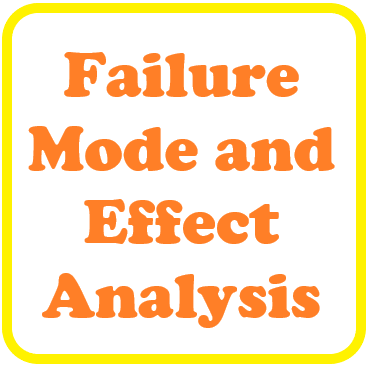Failure Mode and Effect Analysis of a product
1. PURPOSE
FMEA is a methodology used to analyze the failure or defect of a process, product or system and to plan the preventive (or corrective) actions necessary to mitigate the risk of occurrence of a given defect. The acronym comes from the English name Failure Modes and Effects Analysis.
Generally (but not necessarily) the analysis is performed in advance and is therefore based on theoretical and non-experimental considerations. Subsequently, the analysis is integrated in relation to defects found during the operating phases. In this sense, the FMEA document should be considered a "living document" that must be continuously updated according to the experience gained on the product/process being assessed.
The purpose of this procedure is to establish the methodologies and criteria adopted by ‘FIRM’ to conduct the FMEA process analysis, also called PFMEA, which aims to identify and mitigate potential failure modes associated with the production process.
2. APPLICABILITY
This procedure applies to all structures of ‘firm’.3. REFERENCES
SEE- EN ISO 9000:2015 - Quality Management system: Fundamentals and vocabularySEE- EN ISO 9001:2015 - Quality Management system: Requirements IRIS Rev. 03 - International Railway Industry Standard ‘FIRM’ Quality manual - applicable revision
4. TERMS & DEFINITIONS
The definitions contained in the above mentioned UNI EN ISO 9000:2015 and IRIS Rev. 3.5. FMEA OF MACHINING PROCESS
For the development of the process FMEA the entire product construction cycle subdivided into its main sub-processes must be taken into consideration, generally:Marking of a component to ensure machining allowance ;
Setting on a CNC machine;
Program loading on CNC;
Tool setting;
Coolant;
Operator;
Inspection.
For each sub-process, all processing steps must be analyzed in order to identify potential failure modes
(what may go wrong, what could preclude the successful completion of the production phase, etc. ...).
For the FMEA analysis, it is necessary to use a special module that provides a reference framework for conducting the analysis.
किसी उत्पाद का विफलता मोड और प्रभाव विश्लेषण
1। उद्देश्य
FMEA एक प्रक्रिया, उत्पाद या प्रणाली की विफलता या दोष का विश्लेषण करने और किसी दिए गए दोष की घटना के जोखिम को कम करने के लिए आवश्यक निवारक (या सुधारात्मक) कार्यों की योजना बनाने के लिए उपयोग किया जाता है। संक्षिप्त नाम अंग्रेजी नाम फेल्योर मोड्स एंड इफेक्ट्स एनालिसिस से आया है।
आम तौर पर (लेकिन जरूरी नहीं) विश्लेषण अग्रिम में किया जाता है और इसलिए सैद्धांतिक और गैर-प्रयोगात्मक विचारों पर आधारित है। इसके बाद, विश्लेषण ऑपरेटिंग चरणों के दौरान पाए गए दोषों के संबंध में एकीकृत है। इस अर्थ में, FMEA दस्तावेज़ को "जीवित दस्तावेज़" माना जाना चाहिए जिसे उत्पाद / प्रक्रिया पर प्राप्त अनुभव के अनुसार निरंतर अद्यतन किया जाना चाहिए।
इस प्रक्रिया का उद्देश्य FMEA प्रक्रिया विश्लेषण, जिसे PFMEA भी कहा जाता है, का संचालन करने के लिए ’FIRM’ द्वारा अपनाई गई पद्धतियों और मानदंडों को स्थापित करना है, जिसका उद्देश्य उत्पादन प्रक्रिया से जुड़े संभावित विफलता मोड की पहचान करना और उन्हें कम करना है।
2. आवेदन
यह प्रक्रिया 'फर्म' की सभी संरचनाओं पर लागू होती है।
3. संदर्भ
SEE- EN ISO 9000: 2015 - गुणवत्ता प्रबंधन प्रणाली: बुनियादी बातों और शब्दावली
SEE- EN ISO 9001: 2015 - गुणवत्ता प्रबंधन प्रणाली: आवश्यकताएँ IRIS Rev. 03 - अंतर्राष्ट्रीय रेलवे उद्योग मानक M FIRM 'गुणवत्ता मैनुअल - लागू संशोधन
4. नियम और शर्तें
उपर्युक्त परिभाषाएँ UNI EN ISO 9000: 2015 और IRIS Rev. 3 में निहित हैं।
5. मशीनिंग प्रक्रिया का एफएमईए
प्रक्रिया के विकास के लिए FMEA पूरे उत्पाद निर्माण चक्र को अपनी मुख्य उप-प्रक्रियाओं में विभाजित करती है जिसे आम तौर पर ध्यान में रखा जाना चाहिए:
मशीनिंग भत्ता सुनिश्चित करने के लिए एक घटक का अंकन;
एक सीएनसी मशीन पर सेटिंग;
सीएनसी पर कार्यक्रम लोड हो रहा है;
टूल सेटिंग;
शीतलक;
ऑपरेटर;
निरीक्षण।
प्रत्येक उप-प्रक्रिया के लिए संभावित विफलता मोड की पहचान करने के लिए सभी प्रसंस्करण चरणों का विश्लेषण किया जाना चाहिए
(क्या गलत हो सकता है, क्या उत्पादन चरण के सफल समापन को रोक सकता है, आदि ...)।
FMEA विश्लेषण के लिए, एक विशेष मॉड्यूल का उपयोग करना आवश्यक है जो विश्लेषण करने के लिए एक संदर्भ ढांचा प्रदान करता है।


No comments:
New comments are not allowed.